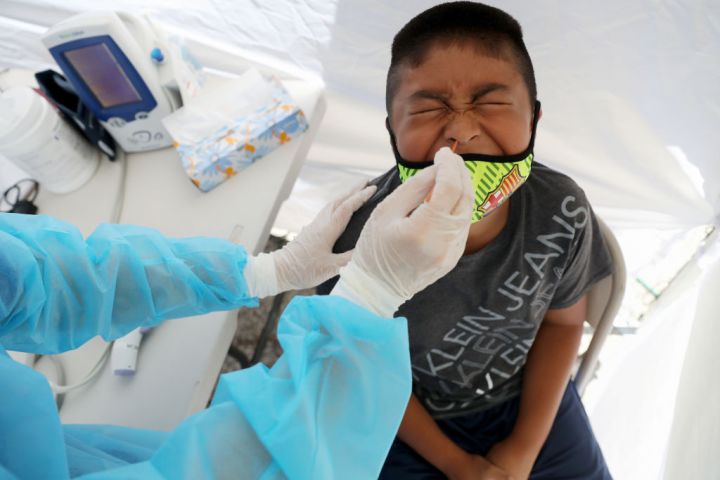
Finding a COVID-19 test site for kids can be a struggle
Finding a COVID-19 test site for kids can be a struggle

Between school and day care, there are many places where kids could be exposed to the coronavirus — which makes testing all the necessary. But how easy is it to get tests for young kids, especially kids who aren’t showing any coronavirus symptoms? Sarah Kliff, an investigative reporter at The New York Times, saw firsthand that is isn’t always easy. Kliff co-authored a story looking nationwide at COVID-19 tests for kids, and spoke to “Marketplace” host Kai Ryssdal about her reporting. The following is a transcript of their interview.
Kai Ryssdal: So we should say, first of all, your son is fine. But this whole episode for you set in motion a chain of reporting events that led you to some interesting conclusions about, first of all, kids and testing in this economy. Lay out what you found.
Sarah Kliff: Yeah, it really surprised me when I was trying to get my son tested — how hard it was to find a testing site that would see a toddler. And I’m in the lucky position. When I find something weird about the health care system, I can spend my days exploring the answer to how things ended up that way. And what I learned is that we really have a dearth of pediatric coronavirus testing in the United States. You know, a lot of these testing sites independently for different reasons, because they didn’t have a specialty in pediatrics, because of patient privacy concerns, decided not to test children. But that kind of leaves us in a situation where schools are reopening, and it can actually be pretty hard for kids to get tested for coronavirus.
Ryssdal: And the catch, of course, is that the young kids are the ones who need the most care, right? And people have full time jobs, and you know how to navigate the American health care system probably better than most, and yet it was still challenging for you.
Kliff: Right. I ended up spending, you know, a half day trying to figure out where I could get my son tested. And that’s a half day when my day care was closed because there’d been coronavirus at my day care. And I think one of the other things you’re seeing is a number of child care facilities and schools, they’ve set up policies where if a child is symptomatic, you know — and that could be a runny nose or a cough — they can’t come back until they have a negative coronavirus test. And that could put parents in a real catch-22 situation, where you need the negative test to get your kid back to child care. That’s a another burden on working parents who have already found themselves pretty burdened throughout this whole pandemic.
Ryssdal: Yeah, can we back out for a second and sort of take a bigger-picture view? And I want to talk about a story you had in the paper today about people getting stuck with testing bills for what they thought was a free COVID test, and yet these things run conceivably in the many hundreds or thousands of dollars, and people are sort of without recourse. Tell me about that.
Kliff: Yeah, so this is something I’ve been looking into over the past month or so, you know, what I found examining a number of patient bills is that a lot of patients are being charged for these things. And a lot of it just comes down to the complexity of our health care system where a provider might not code the visit the right way, and the insurance company doesn’t realize it’s a coronavirus test or a provider tacks on a few extra tests that the patient didn’t even realize was being ordered. So we have this really complex medical system that is set up to build patients but it is not set up to make one service, you know, completely free of charge. And patients across the country, they’re finding the loopholes and then the shortfalls in these rules that are meant to protect them.
Ryssdal: OK, but here’s the the policy question that I’m going to ask you to bring your experience to bear on here. We have a public health crisis in this country. And yet what we are seeing through reporting like yours and others, is that the lack of a uniform system, or a uniform policy, is actually making the health crisis, in this specific instance, worse. Is that fair?
Kliff: Oh, I think that’s totally fair. We don’t have a national health service in the United States like Canada does, or like Britain does, where they can, you know, make decisions from the top down. We have testing sites across the country that decide what age kids they’re going to test, and we have insurance companies who decide, “OK, here’s how we’re going to figure out how to cover the coronavirus tests.” And it just creates this climate where testing can both be difficult to access in the case of kids, and it can be quite expensive in really the case of anybody.
Do you want to help Sarah Kliff and her team investigate the costs of health care? You can submit your medical bills here.
There’s a lot happening in the world. Through it all, Marketplace is here for you.
You rely on Marketplace to break down the world’s events and tell you how it affects you in a fact-based, approachable way. We rely on your financial support to keep making that possible.
Your donation today powers the independent journalism that you rely on. For just $5/month, you can help sustain Marketplace so we can keep reporting on the things that matter to you.











